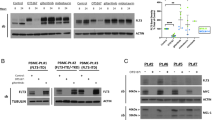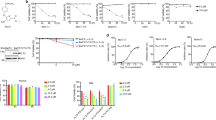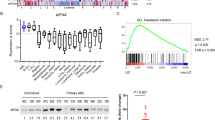Abstract
17-allylamino-17-demethoxygeldanamycin (17-AAG), an inhibitor of the molecular chaperone heat shock protein 90, results in cell type-specific inhibition of proliferation of leukemic cells. GTP14564 is a tyrosine kinase inhibitor actively against FLT3. The current study evaluated the single and combined effects of 17-AAG and GTP14564, and the role of FLT3 in their inhibitory effects. The importance of FLT3 mutations was demonstrated using small interfering RNA (siRNA) targeted to FLT3. Similar to FLT3 siRNA, GTP14564 inhibited FLT3 internal tandem duplication (ITD) cells (MV4;11) and FLT3 amplified wild-type cells (SEMK2-M1), but not wild-type FLT3 cells (RS4;11). However, when RS4;11 cells were stimulated with FLT3-ligand, phosphorylation of STAT5 and GTP14564 inhibition were observed. Responses to GTP14564 in all cell types were directly related to the level of STAT5 phosphorylation in the cells. We observed synergistic effects of combined 17-AAG and GTP14564 in cell lines with FLT3-ITD and amplified wild-type FLT3. Combined treatment with 17-AAG and GTP14564 reduced the levels of p-FLT3 and p-STAT5, enhanced G0/G1 arrest and apoptosis in FLT3-ITD and amplified wild-type FLT3. The combination of 17-AAG with FLT3 kinase inhibitors can enhance targeted therapy in leukemias with FLT3 mutations, such as MLL fusion gene leukemias.
This is a preview of subscription content, access via your institution
Access options
Subscribe to this journal
Receive 12 print issues and online access
$259.00 per year
only $21.58 per issue
Buy this article
- Purchase on Springer Link
- Instant access to full article PDF
Prices may be subject to local taxes which are calculated during checkout






Similar content being viewed by others
References
Armstrong SA, Staunton JE, Silverman LB, Pieters R, den Boer ML, Minden MD et al. MLL translocations specify a distinct gene expression profile that distinguishes a unique leukemia. Nat Genet 2002; 20: 41–47.
Gilliland DG, Griffin JD . The roles of FLT3 in hematopoiesis and leukemia. Blood 2002; 100: 1532–1542.
Sawyers CL . Finding the next Gleevec: FLT3 targeted kinase inhibitor therapy for acute myeloid leukemia. Cancer Cell 2002; 1: 413–415.
Stirewalt DL, Radich JP . The role of FLT3 in haematopoietic malignancies. Nat Rev Cancer 2003; 3: 650–665.
Levis M, Small D . FLT3: ITDoes matter in leukemia. Leukemia 2003; 17: 1738–1752.
Armstrong SA, Kung AL, Mabon ME, Silverman LB, Stam RW, Den Boer ML et al. Inhibition of FLT3 in MLL. Validation of a therapeutic target identified by gene expression based classification. Cancer Cell 2003; 3: 173–183.
O'Farrell AM, Foran JM, Fiedler W, Serve H, Paquette RL, Cooper MA et al. An innovative phase I clinical study demonstrates inhibition of FLT3 phosphorylation by SU11248 in acute myeloid leukemia patients. Clin Cancer Res 2003; 9: 5465–5476.
Levis M, Allebach J, Tse KF, Zheng R, Baldwin BR, Smith BD et al. A FLT3-targeted tyrosine kinase inhibitor is cytotoxic to leukemia cells in vitro and in vivo. Blood 2002; 99: 3885–3891.
Kelly LM, Yu JC, Boulton CL, Apatira M, Li J, Sullivan CM, Williams I et al. CT53518, a novel selective FLT3 antagonist for the treatment of acute myelogenous leukemia (AML). Cancer Cell 2002; 1: 421–432.
Yee KW, O’Farrell AM, Smolich BD, Cherrington JM, McMahon G, Wait CL et al. SU5416 and SU5614 inhibit kinase activity of wild-type and mutant FLT3 receptor tyrosine kinase. Blood 2002; 100: 2941–2949.
O'Farrell AM, Abrams TJ, Yuen HA, Ngai TJ, Louie SG, Yee KW et al. SU11248 is a novel FLT3 tyrosine kinase inhibitor with potent activity in vitro and in vivo. Blood 2003; 101: 3597–3605.
Murata K, Kumagai H, Kawashima T, Tamitsu K, Irie M, Nakajima H et al. Selective cytotoxic mechanism of GTP-14564, a novel tyrosine kinase inhibitor in leukemia cells expressing a constitutively active Fms-like tyrosine kinase 3 (FLT3). J Biol Chem 2003; 278: 32892–32898.
Minami Y, Kiyoi H, Yamamoto Y, Yamamoto K, Ueda R, Saito H et al. Selective apoptosis of tandemly duplicated FLT3-transformed leukemia cells by Hsp90 inhibitors. Leukemia 2002; 16: 1535–1540.
Yao Q, Nishiuchi R, Li Q, Kumar AR, Hudson WA, Kersey JH . FLT3 expressing leukemias are selectively sensitive to inhibitors of the molecular chaperone heat shock protein 90 through destabilization of signal transduction-associated kinases. Clin Cancer Res 2003; 9: 4483–4493.
Neckers L . Hsp90 inhibitors as novel cancer chemotherapeutic agents. Trends Mol Med 2002; 8: S55–S61.
Munster PN, Basso A, Solit D, Norton L, Rosen N . Modulation of Hsp90 function by ansamycins sensitizes breast cancer cells to chemotherapy-induced apoptosis in an RB- and schedule-dependent manner. Clin Cancer Res 2001; 7: 2228–2236.
Rahmani M, Yu C, Dai Y, Reese E, Ahmed W, Dent P et al. Coadministration of the heat shock protein 90 antagonist 17-allylamino-17-demethoxygeldanamycin with suberoylanilide hydroxamic acid or sodium butyrate synergistically induces apoptosis in human leukemia cells. Cancer Res 2003; 63: 8420–8427.
Solit DB, Basso AD, Olshen AB, Scher HI, Rosen N . Inhibition of heat shock protein 90 function down-regulates Akt kinase and sensitizes tumors to Taxol. Cancer Res 2003; 63: 2139–2144.
Vasilevskaya IA, Rakitina TV, O'Dwyer PJ . Geldanamycin and its 17-allylamino-17-demethoxy analogue antagonize the action of Cisplatin in human colon adenocarcinoma cells: differential caspase activation as a basis for interaction. Cancer Res 2003; 63: 3241–3246.
Jia W, Yu C, Rahmani M, Krystal G, Sausville EA, Dent P et al. Synergistic antileukemic interactions between 17-AAG and UCN-01 involve interruption of RAF/MEK- and AKT-related pathways. Blood 2003; 102: 1824–1832.
George P, Bali P, Cohen P, Tao J, Guo F, Sigua C et al. Cotreatment with 17-allylamino-demethoxygeldanamycin and FLT-3 kinase inhibitor PKC412 is highly effective against human acute myelogenous leukemia cells with mutant FLT-3. Cancer Res 2004; 64: 3645–3652.
Spiekermann K, Bagrintseva K, Schwab R, Schmieja K, Hiddemann W . Overexpression and constitutive activation of FLT3 induces STAT5 activation in primary acute myeloid leukemia blast cells. Clin Cancer Res 2003; 9: 2140–2150.
Grundler R, Thiede C, Miething C, Steudel C, Peschel C, Duyster J . Sensitivity toward tyrosine kinase inhibitors varies between different activating mutations of the FLT3 receptor. Blood 2003; 102: 646–651.
Zhang S, Fukuda S, Lee Y, Hangoc G, Cooper S, Spolski R et al. Essential role of signal transducer and activator of transcription Stat5a but not Stat5b for Flt3-dependent signaling. J Exp Med 2000; 192: 719–728.
Birkenkamp KU, Geugien M, Lemmink HH, Kruijer W, Vellenga E . Regulation of constitutive STAT5 phosphorylation in acute myeloid leukemia blasts. Leukemia 2001; 15: 1923–1931.
Dykxhoorn DM, Novina CD, Sharp PA . Killing the messenger: short RNAs that silence gene expression. Nat Rev Mol Cell Biol 2003; 4: 457–467.
Taketani T, Taki T, Sugita K, Furuichi Y, Ishii E, Hanada R et al. FLT3 mutations in the activation loop of tyrosine kinase domain are frequently found in infant ALL with MLL rearrangements and pediatric ALL with hyperdiploidy. Blood 2004; 103: 1085–1088.
Acknowledgements
Supported in part from a grant from the National Cancer Institute (CA087053) to JK and the Childrens Cancer Research Fund to JK.
Author information
Authors and Affiliations
Corresponding author
Rights and permissions
About this article
Cite this article
Yao, Q., Nishiuchi, R., Kitamura, T. et al. Human leukemias with mutated FLT3 kinase are synergistically sensitive to FLT3 and Hsp90 inhibitors: the key role of the STAT5 signal transduction pathway. Leukemia 19, 1605–1612 (2005). https://doi.org/10.1038/sj.leu.2403881
Received:
Accepted:
Published:
Issue Date:
DOI: https://doi.org/10.1038/sj.leu.2403881
Keywords
This article is cited by
-
Targeting the FMS-like tyrosine kinase 3 in acute myeloid leukemia
Leukemia (2012)
-
Downstream molecular pathways of FLT3 in the pathogenesis of acute myeloid leukemia: biology and therapeutic implications
Journal of Hematology & Oncology (2011)
-
Heat shock proteins in animal neoplasms and human tumours—a comparison
Cell Stress and Chaperones (2008)
-
Antitumor activity of sorafenib in FLT3-driven leukemic cells
Leukemia (2007)



